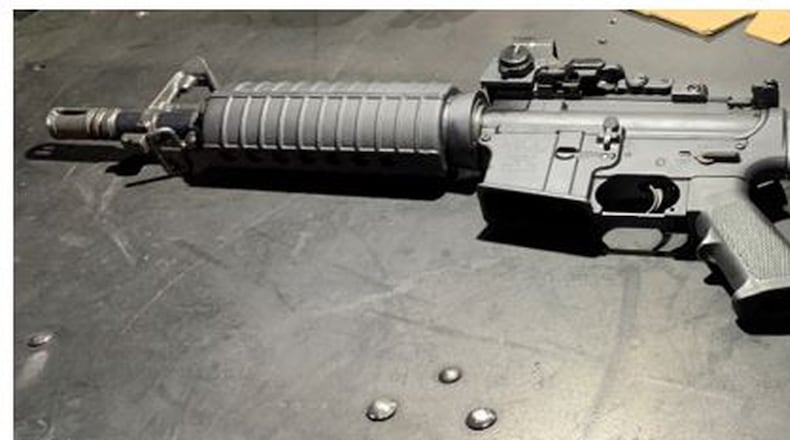The rule does not outlaw the braces or the use of them, but does require gun owners to pay a $200 tax, register the weapon and be subject to a background check for all transfers, including private ones.
Opponents of the new rule said it erodes Second Amendment rights.
“Any politician who calls themselves pro-gun should be fighting against this tooth and nail,” said Dudley Brown, president of the National Association for Gun Rights.
Supporters of the rule said it helps make communities more safe.
“Dayton has experienced the serious harm short-barreled rifles can inflict first-hand in the Oregon District mass shooting,” said Dayton Mayor Jeffrey Mims Jr. “I applaud this new rule to regulate converted pistols like rifles, it is an important step forward in increasing accountability and public safety in local communities.”
Credit: STAFF
Credit: STAFF
On Aug. 4, 2019 Connor Betts, 24, of Bellbrook opened fire in the Oregon District with a semi-automatic pistol that was modified with a brace and an attached drum magazine that could hold up to 100 .223-caliber rounds. In less than a minute he killed nine people, including his sister, and injured more than two dozen others before police shot him to death.
A 26-month investigation by Dayton Police and the FBI was unable to determine a motive for Betts’ rampage but found he acted alone and had a history of mental illness as well as suicidal and violent fantasies, according to a report issued in September 2021.
Surveillance video before the shooting showed Betts walking with a large backpack, which police believe contained the parts of his gun, before he opened fire.
Those killed in the shooting were Monica Brickhouse, 39; Nicholas Cumer, 25; Megan Betts, 22; Derrick Fudge, 57; Thomas McNichols, 25; Lois Oglesby, 27; Saheed Saleh, 38; Logan Turner, 30; and Beatrice Warren Curtis, 36.
“None of us are ever going to understand the mind of someone like Conner Betts that did what he did. So if we are trying to put ourselves in his shoes and say if this (brace) had not been readily available he wouldn’t have committed that crime, I don’t think I can make that leap,” said Evan English, president and owner of Olde English Outfitters in Tipp City. “Because had he not been able to get that brace he would have done it with something else. The brace didn’t make the criminal.”
At an event with President Joe Biden in April 2021 U.S. Attorney General Merrick B. Garland announced the Bureau of Alcohol, Tobacco, Firearms, and Explosives (ATF) would work on a variety of initiatives to reduce gun violence, including making clear that existing restrictions on short-barreled rifles applied to pistols with certain stabilizing braces.
“This rule enhances public safety and prevents people from circumventing the laws Congress passed almost a century ago. In the days of Al Capone, Congress said back then that short-barreled rifles and sawed-off shotguns should be subjected to greater legal requirements than most other guns,” ATF Director Steven Dettelbach said in the justice department’s January news release.
“The reason for that is that short-barreled rifles have the greater capability of long guns, yet are easier to conceal, like a pistol.”
Manufacturers, dealers and individuals have a 120-day period starting Jan. 31 to register tax-free any existing short-barreled rifles covered by the rule. Gun owners can also comply by removing the stabilizing brace to make the firearm a pistol or by surrendering short-barreled rifles covered by the rule to ATF.
“This rule does not affect ‘stabilizing braces’ that are objectively designed and intended as a ‘stabilizing brace’ for use by individuals with disabilities, and not for shouldering the weapon as a rifle. Such stabilizing braces are designed to conform to the arm and not as a buttstock,” according to an ATF summary of the rule.
English said he has stopped selling pistols equipped with stabilizing braces as well as the braces themselves, which cost $100 to $300. He said the rule is not fair to law-abiding citizens who own or want to use the braces.
Brown said the new rule sets a dangerous precedent and he is supporting U.S. House Republicans’ proposed legislation rolling back the rule.
“This is government overreach, the expansion of an already unconstitutional registry, and forced destruction of private property — plain and simple,” Brown said in a Tuesday news release. “We look forward to fighting against this ridiculous registry scheme and holding these anti-gun government bureaucrats accountable for betraying their oath to the U.S. Constitution.”
The new federal rule is supported by Rev. Jack Sullivan Jr., executive director of the Ohio Council of Churches, which this year is absorbing the non-profit group, Ohio Coalition Against Gun Violence.
“I think it represents a clear signal of hope for all people who are interested in the continuation of human life,” said Sullivan. “I do think it will make a difference. I think anything that can prevent mass shootings with weaponry that is designed for a massive amount of carnage in the fastest period of time, any weaponry like that has no place on our streets and in our society.”
Follow @LynnHulseyDDN on Twitter and Facebook
About the Author



